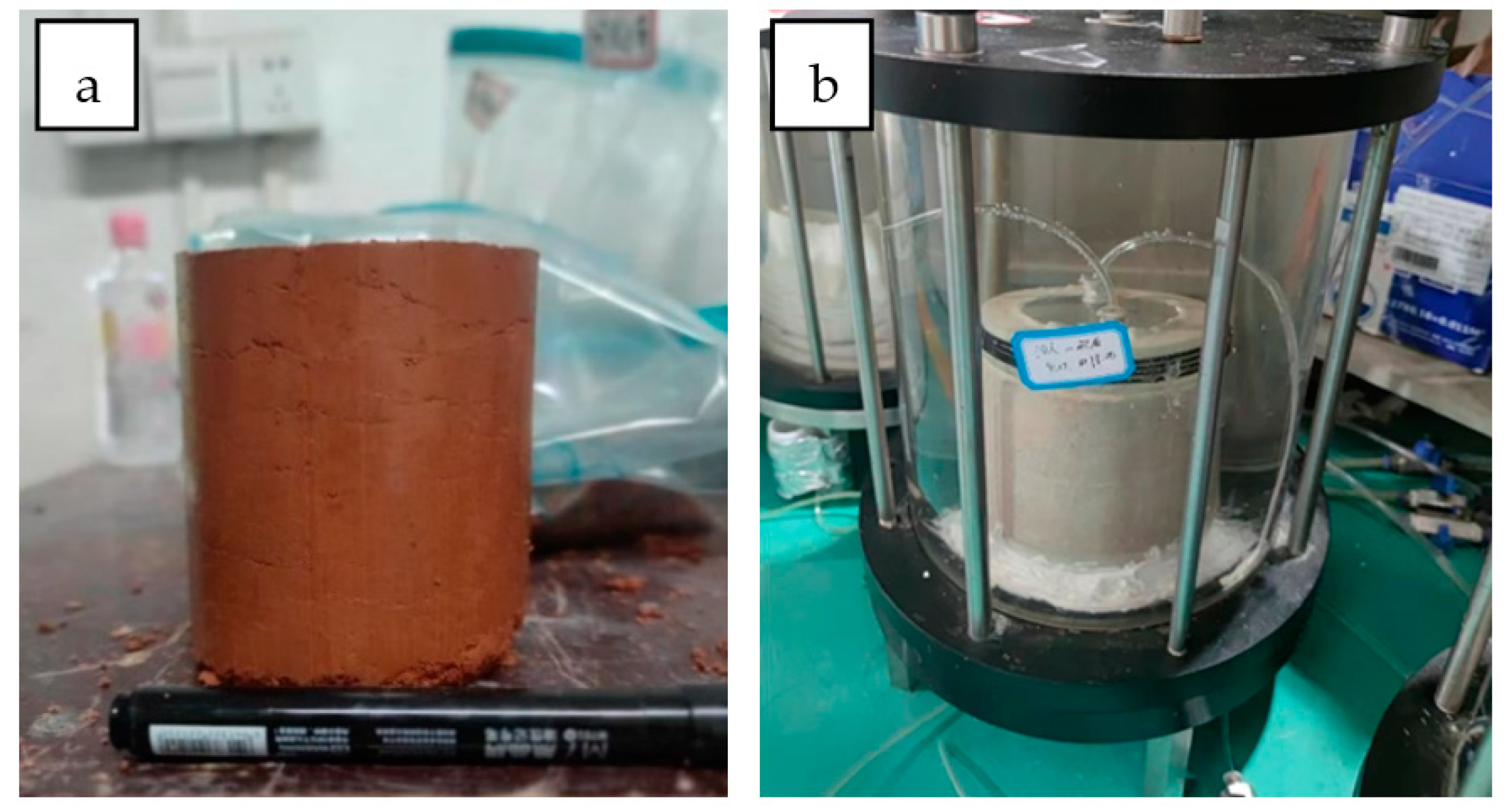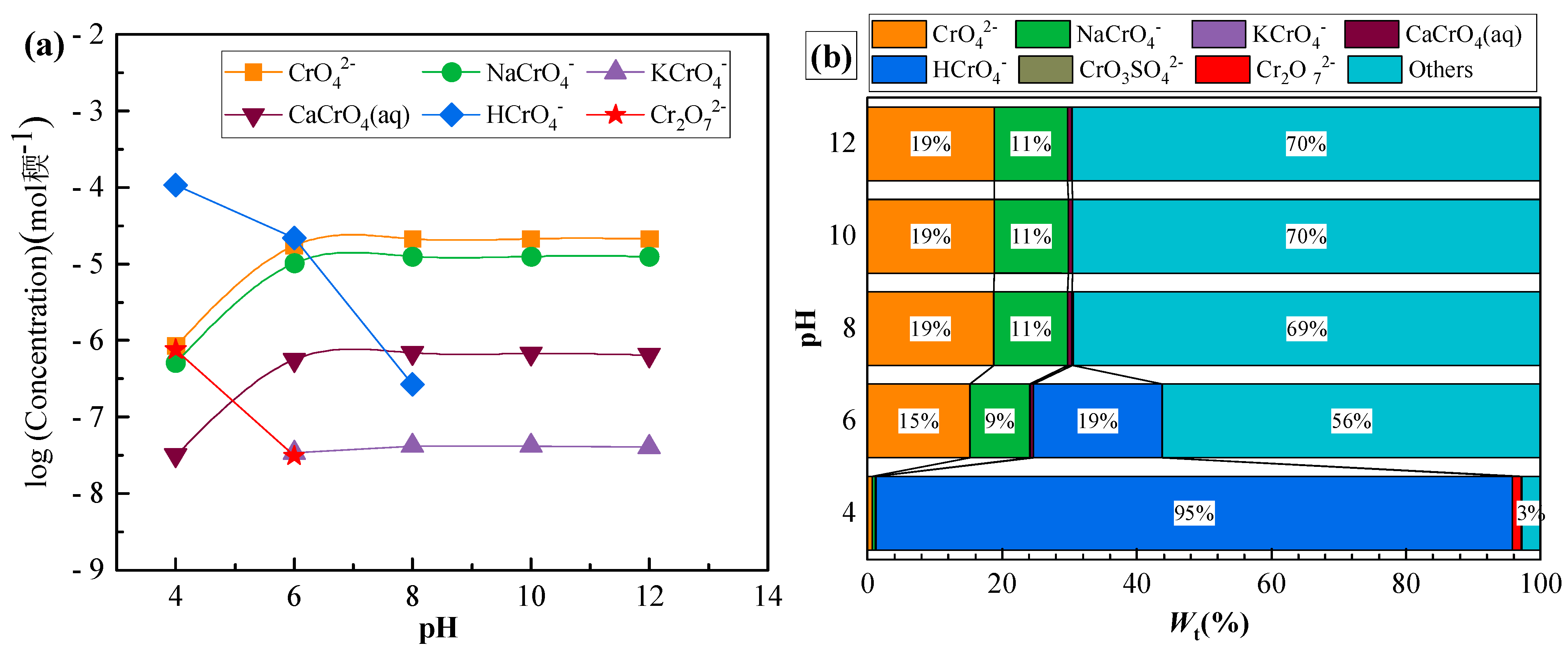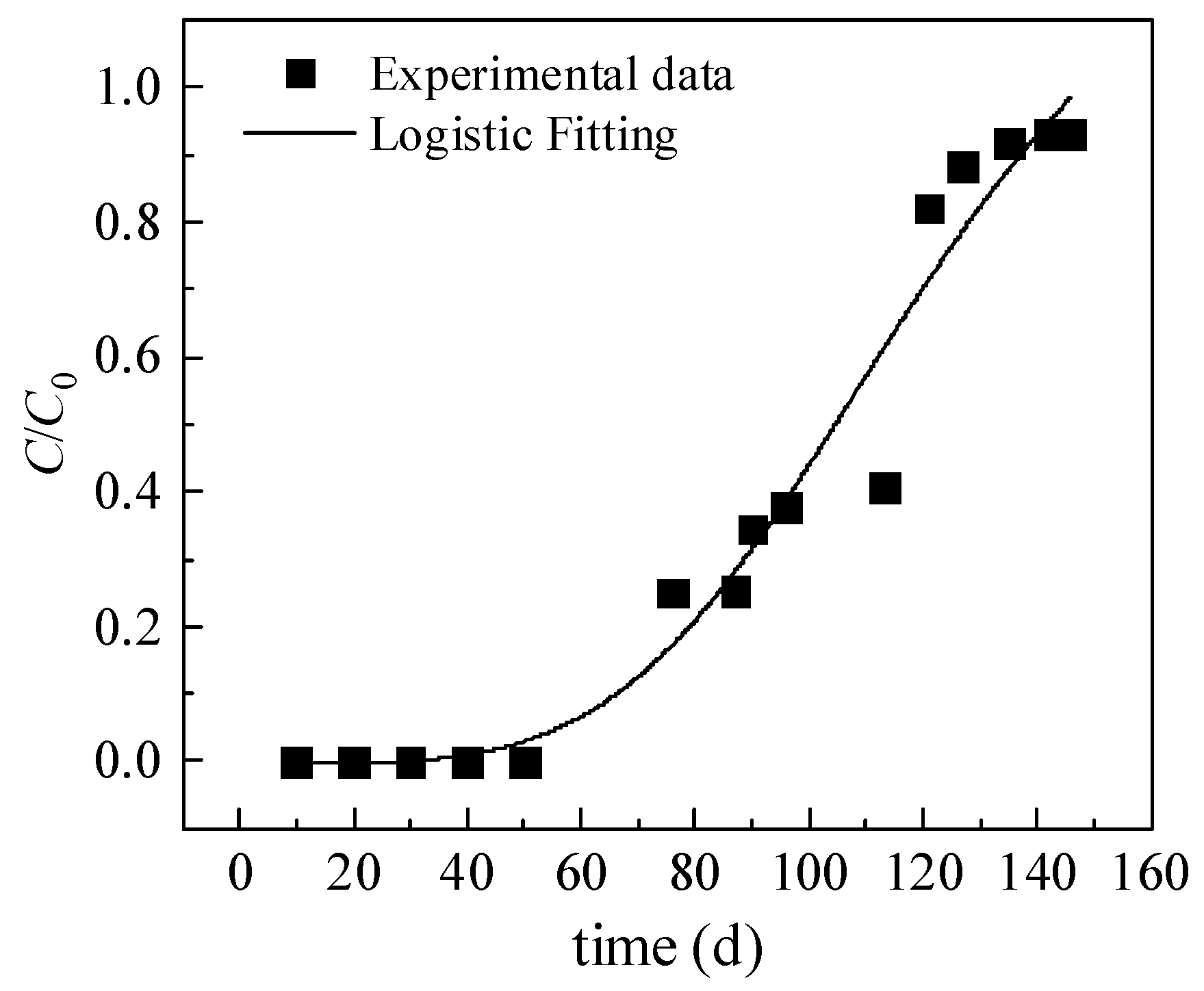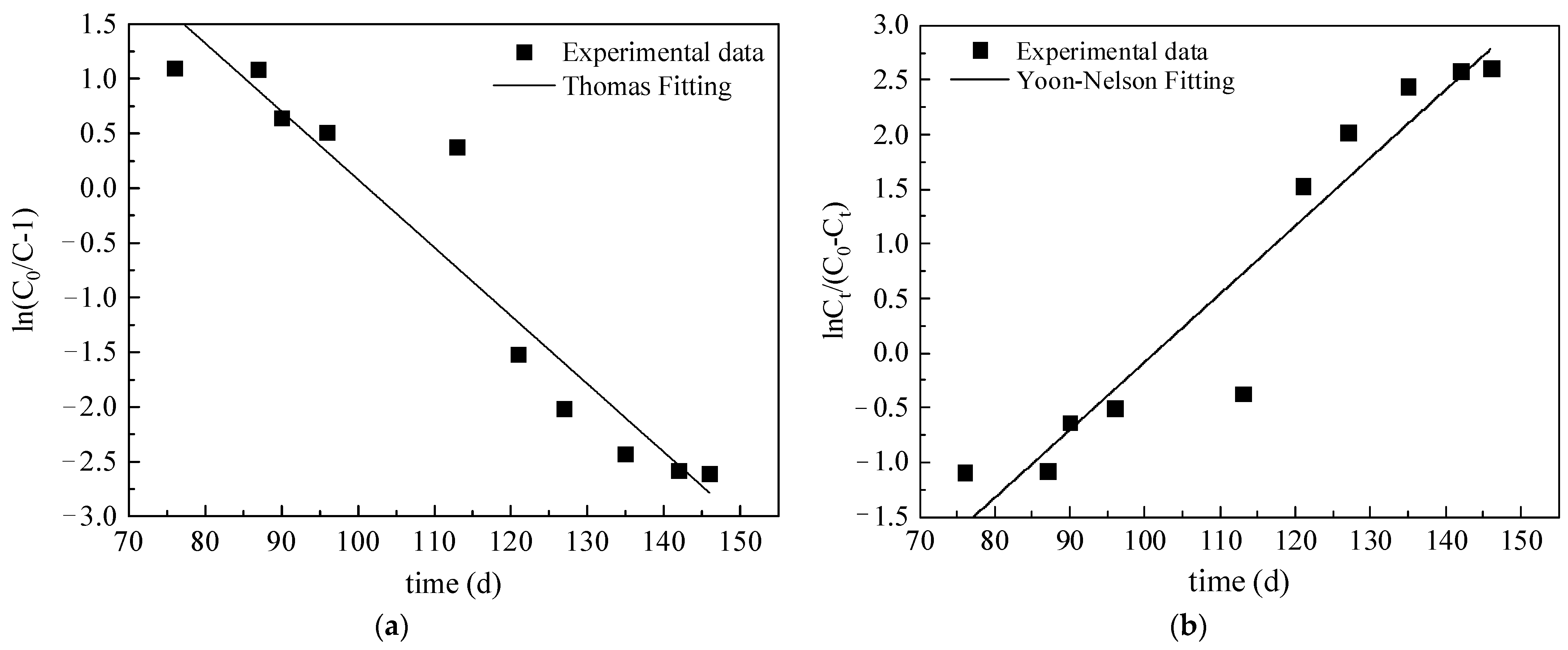Dynamic Adsorption Characteristics of Cr(VI) in Red-Mud Leachate onto a Red Clay Anti-Seepage Layer
Abstract
:1. Introduction
2. Materials and Methods
2.1. Red-Clay Properties
2.2. Leachate Properties
2.3. Numerical Simulation of Cr(VI) Adsorption onto Red Clay
2.4. Dynamic Adsorption Test of Red-Mud Leachate onto a Clay Anti-Seepage Layer
3. Results and Discussion
3.1. Static Adsorption Simulation
3.2. Dynamic Adsorption Test Results
3.3. Dynamic Models
4. Conclusions
- (1)
- The geochemical equilibrium software (Visual MINTEQ) simulation indicated that Cr(VI) adsorption in red-mud leachate onto clay was 69.9%, which was considered adequate. With increasing pH in the solution, Cr(VI) adsorption gradually increased, thereby achieving better adsorption under alkaline conditions.
- (2)
- The soil column breakthrough test revealed that the Cr(VI) concentration in the effluent reached 93% of the initial concentration when the adsorption time reached 146 d. The experimental adsorption data were fitted with a logistic function, so as to describe the variations in concentration ratio over time. The logistic breakthrough model properly fit the dynamic adsorption process. The adsorption of Cr(VI) onto the clay anti-seepage layer under low flow-rate conditions was more persistent, requiring a longer time for Cr(VI) to completely penetrate the clay layer.
- (3)
- Both the Thomas and the Yoon–Nelson models showed good correlations between their fitting results and the experimental measurements. The maximum adsorption capacity, q0, of the clay layer for Cr(VI) in red-mud leachate was approximately 0.634 mg/kg−1, according to the Thomas model. The Yoon–Nelson model estimated the time to reach the breakthrough point with C/C0 = 50% at 101 d, similar to the experimental result of 105 d. The parameters obtained from both models were reliable and could be used to predict the breakthrough curve of Cr(VI) in a clay layer.
Author Contributions
Funding
Institutional Review Board Statement
Informed Consent Statement
Data Availability Statement
Conflicts of Interest
References
- Sun, C.; Chen, J.; Tian, K.; Peng, D.; Liao, X.; Wu, X. Geochemical characteristics and toxic elements in alumina refining wastes and leachates from management facilities. Int. J. Environ. Res. Public Health 2019, 16, 1297. [Google Scholar] [CrossRef] [PubMed] [Green Version]
- Borra, C.R.; Pontikes, Y.; Binnemans, K.; Van Gerven, T. Leaching of rare earths from bauxite residue (red mud). Miner. Eng. 2015, 76, 20–27. [Google Scholar] [CrossRef] [Green Version]
- Wu, C.; Li, C.; Jiang, J.; Hartley, W.; Kong, X.; Wu, Y.; Xue, S. Revealing the alkaline characteristic evolution of bauxite residue under biomass fermentation. J. Soils Sediments 2020, 20, 3083–3090. [Google Scholar] [CrossRef]
- Clark, M.W.; Johnston, M.; Reichelt-Brushett, A.J. Comparison of several different neutralisations to a bauxite refinery residue: Potential effectiveness environmental ameliorants. Appl. Geochem. 2015, 56, 1–10. [Google Scholar] [CrossRef]
- Xue, S.; Kong, X.; Zhu, F.; Hartley, W.; Li, X.; Li, Y. Proposal for management and alkalinity transformation of bauxite residue in China. Environ. Sci. Pollut. Res. 2016, 23, 12822–12834. [Google Scholar] [CrossRef] [PubMed]
- Economou-Eliopoulos, M.; Frei, R.; Megremi, I. Potential leaching of Cr (VI) from laterite mines and residues of metallurgical products (red mud and slag): An integrated approach. J. Geochem. Explor. 2016, 162, 40–49. [Google Scholar] [CrossRef]
- Lu, H.; Lan, J.; Ling, R. Evaluation of the effect of the red mud stack field on the karst groundwater pollution in Pingguo County, Guangxi. J. Saf. Environ. 2015, 15, 295–300. (In Chinese) [Google Scholar]
- Rubinos, D.A.; Barral, M.T. Fractionation and mobility of metals in bauxite red mud. Environ. Sci. Pollut. Res. 2013, 20, 7787–7802. [Google Scholar] [CrossRef]
- Tilwankar, V.; Rai, S.; Bajpai, S.P. A review on contamination profile of heavy metals and its role in environment. Plant Arch. 2018, 18, 1239–1247. [Google Scholar]
- Prasad, S.; Yadav, K.K.; Kumar, S.; Gupta, N.; Cabral-Pinto, M.M.; Rezania, S.; Radwan, N.; Alam, J. Chromium contamination and effect on environmental health and its remediation: A sustainable approaches. J. Environ. Manag. 2021, 285, 112174. [Google Scholar] [CrossRef]
- Khan, K.; Mohsin, A.; Sharif, H.M.A.; Maryam, A.; Ali, J.; Li, X.; Ibrahim, S.M.; Ayaz, M.; Zhou, Y.; Younas, M. Heavy metal pollution in the soil of a riverine basin: Distribution, source, and potential hazards. Environ. Monit. Assess. 2022, 194, 618. [Google Scholar] [CrossRef] [PubMed]
- Li, Z. Research on environmental protection treatment technology based on heavy metal polluted water body. Environ. Dev. 2018, 30, 110–111. (In Chinese) [Google Scholar]
- Punia, P.; Bharti, M.K.; Dhar, R.; Thakur, P.; Thakur, A. Recent Advances in Detection and Removal of Heavy Metals from Contaminated Water. ChemBioEng Rev. 2022, 9, 351–369. [Google Scholar] [CrossRef]
- Ajiboye, T.O.; Oyewo, O.A.; Onwudiwe, D.C. Simultaneous removal of organics and heavy metals from industrial wastewater: A review. Chemosphere 2021, 262, 128–379. [Google Scholar] [CrossRef] [PubMed]
- Önal, E.S.; Yatkın, T.; Aslanov, T.; Ergüt, M.; Özer, A. Biosynthesis and characterization of iron nanoparticles for effective adsorption of Cr (VI). Int. J. Chem. Eng. 2019, 2019, 2716423. [Google Scholar] [CrossRef]
- Huang, Y.; Fu, C.; Li, Z.; Fang, F.; Ouyang, W.; Guo, J. Effect of dissolved organic matters on adsorption and desorption behavior of heavy metals in a water-level-fluctuation zone of the Three Gorges Reservoir, China. Ecotoxicol. Environ. Saf. 2019, 185, 109695. [Google Scholar] [CrossRef]
- Wang, W.; Ma, H.; Lin, W.; Sun, P.; Zhang, L.; Han, J. Trametes suaveolens-derived biochar loaded on nanoscale zero-valent iron particles for the adsorption and reduction of Cr (VI). Int. J. Environ. Sci. Technol. 2022, 19, 4251–4264. [Google Scholar] [CrossRef]
- Wang, T.; Liu, Y.; Wang, J.; Wang, X.; Liu, B.; Wang, Y. In-situ remediation of hexavalent chromium contaminated groundwater and saturated soil using stabilized iron sulfide nanoparticles. J. Environ. Manag. 2019, 231, 679–686. [Google Scholar] [CrossRef]
- Yi, N.; Wu, Y.; Wei, J.; Zhang, S.; Ji, P. Adsorption of the low concentration Cr (VI) on magnetic chitosan/PVA hydrogel beads. Fresen. Environ. Bull. 2016, 25, 2174–2182. [Google Scholar]
- Zhang, X.; Tong, J.; Hu, B.X.; Wei, W. Adsorption and desorption for dynamics transport of hexavalent chromium (Cr (VI)) in soil column. Environ. Sci. Pollut. Res. 2018, 25, 459–468. [Google Scholar] [CrossRef]
- Deng, L.; Shi, Z.; Li, B.; Yang, L.; Luo, L.; Yang, X. Adsorption of Cr (VI) and phosphate on Mg–Al hydrotalcite supported kaolin clay prepared by ultrasound-assisted coprecipitation method using batch and fixed-bed systems. Ind. Eng. Chem. Res. 2014, 53, 7746–7757. [Google Scholar] [CrossRef]
- Tang, S.C.; Yin, K.; Lo, I.M. Column study of Cr (VI) removal by cationic hydrogel for in-situ remediation of contaminated groundwater and soil. J. Contam. Hydrol. 2011, 125, 39–46. [Google Scholar] [CrossRef] [PubMed]
- Campillo-Cora, C.; Conde-Cid, M.; Arias-Estévez, M.; Fernández-Calviño, D.; Alonso-Vega, F. Specific adsorption of heavy metals in soils: Individual and competitive experiments. Agronomy 2020, 10, 1113. [Google Scholar] [CrossRef]
- Matern, K.; Weigand, H.; Kretzschmar, R.; Mansfeldt, T. Leaching of Hexavalent Chromium from Young Chromite Ore Processing Residue. J. Environ. Qual 2020, 49, 712–722. [Google Scholar] [CrossRef]
- Khan, T.; Isa, M.H.; Mustafa, M.R.U.; Yeek-Chia, H.; Baloo, L.; Abd Manan, T.S.B.; Saeed, M.O. Cr (VI) adsorption from aqueous solution by an agricultural waste based carbon. RSC Adv. 2016, 6, 56365–56374. [Google Scholar] [CrossRef]
- Liu, X.; Chen, X.; Zhang, X.; Guo, H.; Zhang, C.; Zang, X.; Li, B. Quantifying the influence of soil factors on the migration of chromium (VI). Process. Saf. Environ. 2021, 155, 32–40. [Google Scholar] [CrossRef]
- Manoj, S.; Thirumurugan, M.; Elango, L. Determination of distribution coefficient of uranium from physical and chemical properties of soil. Chemosphere 2020, 244, 125411. [Google Scholar] [CrossRef] [PubMed]
- Abo El-Reesh, G.Y.; Farghali, A.A.; Taha, M.; Mahmoud, R.K. Novel synthesis of Ni/Fe layered double hydroxides using urea and glycerol and their enhanced adsorption behavior for Cr (VI) removal. Sci. Rep. 2020, 10, 587. [Google Scholar] [CrossRef] [PubMed] [Green Version]
- Mpouras, T.; Polydera, A.; Dermatas, D.; Verdone, N.; Vilardi, G. Multi wall carbon nanotubes application for treatment of Cr (VI)-contaminated groundwater; Modeling of batch & column experiments. Chemosphere 2021, 269, 128749. [Google Scholar]
- Achary, P.G.R.; Ghosh, M.R.; Mishra, S.P. Insights into the modeling and application of some low cost adsorbents towards Cr (VI) adsorption. Mater. Today Proc. 2020, 30, 267–273. [Google Scholar] [CrossRef]
- American Society for Testing and Materials (ASTM) Standards. Available online: https://www.astm.org/products-services/standards-and-publications/standards.html (accessed on 1 January 1996).
- Allison, J.D.; Brown, D.S.; Novo-Gradac, K.J. MINTEQA2/PRODEFA2, A Geochemical Assessment Model for Environmental Systems, Version 3.0 User’s Manual; Environmental Research Laboratory Office of Research and Development, US Environmental Protection Agency: Athens, GA, USA, 1991. Available online: https://www.epa.gov/sites/production/files/documents/USERMANU.PDF (accessed on 5 March 1991).
- Laperche, V.; Logan, T.J.; Gaddam, P.; Traina, S.J. Effect of apatite amendments on plant uptake of lead from contaminated soil. Environ. Sci. Technol. 1997, 31, 2745–2753. [Google Scholar] [CrossRef]
- Cui, Y.; Chen, J.; Zhang, Y.; Peng, D.; Huang, T.; Sun, C. pH-dependent leaching characteristics of major and toxic elements from red mud. Int. J. Environ. Res. Public Health 2019, 16, 2046. [Google Scholar] [CrossRef] [PubMed] [Green Version]
- Zhang, Y.; Cetin, B.; Likos, W.J.; Edil, T.B. Impacts of pH on leaching potential of elements from MSW incineration fly ash. Fuel 2016, 184, 815–825. [Google Scholar] [CrossRef]
- Yang, X.; Liu, P.; Yao, M.; Sun, H.; Liu, R.; Xie, J.; Zhao, Y. Mechanism and enhancement of Cr (VI) contaminated groundwater remediation by molasses. Sci. Total Environ. 2021, 780, 146580. [Google Scholar] [CrossRef]
- Ashar, A.; Bhatti, I.A.; Jilani, A.; Mohsin, M.; Rasul, S.; Iqbal, J.; Shakoor, M.B.; Al-Sehemi, A.G.; Wageh, S.; Al-Ghamdi, A.A. Enhanced solar photocatalytic reduction of Cr (VI) using a (ZnO/CuO) nanocomposite grafted onto a polyester membrane for wastewater treatment. Polymers 2021, 13, 4047. [Google Scholar] [CrossRef] [PubMed]
- Guerra, D.; Mello, I.; Freitas, L.R.; Resende, R.; Silva, R. Equilibrium, thermodynamic, and kinetic of Cr (VI) adsorption using a modified and unmodified bentonite clay. Int. J. Min. Sci. Technol. 2014, 24, 525–535. [Google Scholar] [CrossRef]
- Pakade, V.E.; Tavengwa, N.T.; Madikizela, L.M. Recent advances in hexavalent chromium removal from aqueous solutions by adsorptive methods. RSC Adv. 2019, 9, 26142–26164. [Google Scholar] [CrossRef] [PubMed] [Green Version]
- Ma, X.L.; Fei, G.T.; Xu, S.H. Synthesis of polyaniline coating on the modified fiber ball and application for Cr (VI) removal. Nanoscale Res. Lett. 2021, 16, 58. [Google Scholar] [CrossRef] [PubMed]
- Tang, Y.; Liao, X.; Zhang, X.; Peng, G.; Gao, J.; Chen, L. Enhanced adsorption of hexavalent chromium and the microbial effect on quartz sand modified with Al-layered double hydroxides. Sci. Total Environ. 2021, 762, 143094. [Google Scholar] [CrossRef] [PubMed]
- Almeida, A.C.M.; Do Nascimento, R.A.; Amador, I.C.B.; de Sousa Santos, T.C.; Martelli, M.C.; de Faria, L.J.G.; Da Paixão Ribeiro, N.F. Chemically activated red mud: Assessing structural modifications and optimizing adsorption properties for hexavalent chromium. Colloids Surf. A 2021, 628, 127325. [Google Scholar] [CrossRef]
- Mthombeni, N.H.; Mbakop, S.; Ray, S.C.; Leswifi, T.; Ochieng, A.; Onyango, M.S. Highly efficient removal of chromium (VI) through adsorption and reduction: A column dynamic study using magnetized natural zeolite-polypyrrole composite. J. Environ. Chem. Eng. 2018, 6, 4008–4017. [Google Scholar] [CrossRef]
- Liu, H.; Zhang, F.; Peng, Z. Adsorption mechanism of Cr (VI) onto GO/PAMAMs composites. Sci. Rep. 2019, 9, 3663. [Google Scholar] [CrossRef] [PubMed] [Green Version]
- Sancho, J.L.S.; Rodríguez, A.R.; Torrellas, S.Á.; Rodríguez, J.G. Removal of an emerging pharmaceutical compound by adsorption in fixed bed column. Desalin. Water Treat. 2012, 45, 305–314. [Google Scholar] [CrossRef]
- Egbosiuba, T.C.; Abdulkareem, A.S.; Kovo, A.S.; Afolabi, E.A.; Tijani, J.O.; Bankole, M.T.; Bo, S.; Roos, W.D. Adsorption of Cr (VI), Ni (II), Fe (II) and Cd (II) ions by KIAgNPs decorated MWCNTs in a batch and fixed bed process. Sci. Rep. 2021, 11, 75. [Google Scholar] [CrossRef] [PubMed]
- Wang, N.; Zhou, X.; Cui, B. Synthesis of a polymeric imidazolium-embedded octadecyl ionic liquid-grafted silica sorbent for extraction of flavonoids. J. Chromatogr. A 2019, 1606, 460376. [Google Scholar] [CrossRef] [PubMed]
- Lu, H.; Zhang, Q.; Dong, Y.; Li, J.; Zhang, X. The adsorption capacity, pore structure, and thermal behavior of the modified clay containing SSA. Adv. Mater. Sci. Eng. 2016, 2016, 9894657. [Google Scholar] [CrossRef] [Green Version]
- Li, N.; Han, Z.; Ren, Y.; Wang, S.; Hu, X.; Zeng, Z. Retarding performance of the vadose zone for nitrogen pollutants derived from municipal solid waste landfills in the red bed zone. J. Environ. Manag. 2022, 306, 114406. [Google Scholar] [CrossRef]
- Lockwood, C.L.; Stewart, D.I.; Mortimer, R.J.; Mayes, W.M.; Jarvis, A.P.; Gruiz, K.; Burke, I.T. Leaching of copper and nickel in soil-water systems contaminated by bauxite residue (red mud) from Ajka, Hungary: The importance of soil organic matter. Environ. Sci. Pollut. Res. 2015, 22, 10800–10810. [Google Scholar] [CrossRef] [PubMed] [Green Version]
- Setshedi, K.Z.; Bhaumik, M.; Onyango, M.S.; Maity, A. Breakthrough studies for Cr (VI) sorption from aqueous solution using exfoliated polypyrrole-organically modified montmorillonite clay nanocomposite. J. Ind. Eng. Chem. 2014, 20, 2208–2216. [Google Scholar] [CrossRef]
- Aharoni, I.; Siebner, H.; Yogev, U.; Dahan, O. Holistic approach for evaluation of landfill leachate pollution potential–From the waste to the aquifer. Sci. Total Environ. 2020, 741, 140367. [Google Scholar] [CrossRef] [PubMed]
- Yan, Y.; An, Q.; Xiao, Z.; Zheng, W.; Zhai, S. Flexible core-shell/bead-like alginate@ PEI with exceptional adsorption capacity, recycling performance toward batch and column sorption of Cr (VI). Chem. Eng. J. 2017, 313, 475–486. [Google Scholar] [CrossRef]
- Hu, Q.; Wang, P.; Jiang, J.; Pan, H.; Gao, D. Column adsorption of aniline by a surface modified jute fiber and its regeneration property. J. Environ. Chem. Eng. 2016, 4, 2243–2249. [Google Scholar] [CrossRef]
- Dhanasekaran, P.; Sai, P.S.; Gnanasekar, K.I. Fixed bed adsorption of fluoride by Artocarpus hirsutus based adsorbent. J. Fluor. Chem. 2017, 195, 37–46. [Google Scholar] [CrossRef]
- Zhang, L.; Niu, W.; Sun, J.; Zhou, Q. Efficient removal of Cr (VI) from water by the uniform fiber ball loaded with polypyrrole: Static adsorption, dynamic adsorption and mechanism studies. Chemosphere 2020, 248, 126102. [Google Scholar] [CrossRef]
- Rodrigues, E.; Almeida, O.; Brasil, H.; Moraes, D.; Dos Reis, M. Adsorption of chromium (VI) on hydrotalcite-hydroxyapatite material doped with carbon nanotubes: Equilibrium, kinetic and thermodynamic study. Appl. Clay Sci. 2019, 172, 57–64. [Google Scholar] [CrossRef]
- Ebiad, M.A.; Abd El-Hafiz, D.R.; Masod, M.B. β-FeOOH/C nanocomposite for elemental mercury removal as a new approach to environmental and natural gas processes. J. Nat. Gas. Sci. Eng. 2020, 80, 103383. [Google Scholar] [CrossRef]
- Omitola, O.B.; Abonyi, M.N.; Akpomie, K.G.; Dawodu, F.A. Adams-Bohart, Yoon-Nelson, and Thomas modeling of the fix-bed continuous column adsorption of amoxicillin onto silver nanoparticle-maize leaf composite. Appl. Water Sci. 2022, 12, 94. [Google Scholar] [CrossRef]
- Liu, L.; Ma, J.; Yu, X.; Zhang, T.; Mkandawire, V.; Li, X. Dynamic Adsorption Properties of Insoluble Humic Acid/Tourmaline Composite Particles for Iron and Manganese in Mine Wastewater. Materials 2022, 15, 4338. [Google Scholar] [CrossRef] [PubMed]
- Singha, S.; Sarkar, U. Analysis of the dynamics of a packed column using semi-empirical models: Case studies with the removal of hexavalent chromium from effluent wastewater. Korean J. Chem. Eng. 2015, 32, 20–29. [Google Scholar] [CrossRef]






| Physical Properties | ||||||||
| Liquid limit (%) | Plastic limit (%) | Plasticity index (%) | Initial moisture content (%) | Optimum water content (%) | Maximum dry density (g/cm3) | Specific gravity (Gs) | Compression index (Cc) | Swelling index (Cs) |
| 46.1 | 29.8 | 16.3 | 13.55 | 24 | 1.64 | 2.71 | 0.05 | 0.024 |
| Chemical composition | ||||||||
| Constituent | SiO2 | Al2O3 | Fe2O3 | CaO | Na2O | MgO | K2O | Other |
| Weight (%) | 55.96 | 26.16 | 6.37 | 0.06 | 0.12 | 0.66 | 1.0 | 9.66 |
| pH | EC@25 °C (mS-cm−1) | ORP (mV) | Ionic Strength (mM) | Elemental Composition (mg·L−1) | |||||||||||
|---|---|---|---|---|---|---|---|---|---|---|---|---|---|---|---|
| Al | Ca | Na | Mg | K | Si | Cl− | F− | NO3− | SO42− | Cr | Cr(VI) | ||||
| 12.6 | 51.1 | −110.0 | 484.3 | 745.5 | 57.1 | 10,650.0 | 10.5 | 81.8 | 89.9 | 6490.5 | 121.8 | 483.4 | 7453.3 | 5.9 | 1.76 |
| Before Adsorption | |||
| Form | Molar Concentration (mol·L−1) | Mass Fraction (%) | Activity (mol·L−1) |
| CrO42− | 7.09 × 10−5 | 62.514 | 2.02 × 10−5 |
| NaCrO4− | 4.05 × 10−5 | 35.658 | 2.96 × 10−5 |
| KCrO4− | 1.33 × 10−7 | 0.117 | 9.7 × 10−8 |
| CaCrO4 (aq) | 1.94 × 10−6 | 1.17 | 2.15 × 10−6 |
| After Adsorption | |||
| Form | Molar Concentration (mol·L−1) | Mass Fraction (%) | Activity (mol·L−1) |
| CrO42− | 2.1347 × 10−5 | 18.813 | 6.0869 × 10−6 |
| NaCrO4− | 1.2177 × 10−5 | 10.731 | 8.8983 × 10−6 |
| Test Conditions | Fitting Formula | R2 |
|---|---|---|
| Cr = 1.76 mg·L−1 Q = 1.129 × 10−3 L·d−1 | 0.96 |
| Fixed Parameters | Thomas Model | Yoon-Nelson Model | |||||
|---|---|---|---|---|---|---|---|
| kTh (L·mg−1·d−1) | q0 (mg·kg−1) | R2 | K | τmod(d) | τexp(d) | R2 | |
| M = 317.45 g Q = 1.129 × 10−3 L·d−1 Cr(VI) = 1.76 mg·L−1 | 0.0354 | 0.634 | 0.920 | 0.0623 | 101 | 105 | 0.920 |
Publisher’s Note: MDPI stays neutral with regard to jurisdictional claims in published maps and institutional affiliations. |
© 2022 by the authors. Licensee MDPI, Basel, Switzerland. This article is an open access article distributed under the terms and conditions of the Creative Commons Attribution (CC BY) license (https://creativecommons.org/licenses/by/4.0/).
Share and Cite
Zhang, Y.; Yu, Y.; Qin, H.; Peng, D.; Chen, X. Dynamic Adsorption Characteristics of Cr(VI) in Red-Mud Leachate onto a Red Clay Anti-Seepage Layer. Toxics 2022, 10, 606. https://doi.org/10.3390/toxics10100606
Zhang Y, Yu Y, Qin H, Peng D, Chen X. Dynamic Adsorption Characteristics of Cr(VI) in Red-Mud Leachate onto a Red Clay Anti-Seepage Layer. Toxics. 2022; 10(10):606. https://doi.org/10.3390/toxics10100606
Chicago/Turabian StyleZhang, Yibo, Yue Yu, Hao Qin, Daoping Peng, and Xing Chen. 2022. "Dynamic Adsorption Characteristics of Cr(VI) in Red-Mud Leachate onto a Red Clay Anti-Seepage Layer" Toxics 10, no. 10: 606. https://doi.org/10.3390/toxics10100606
APA StyleZhang, Y., Yu, Y., Qin, H., Peng, D., & Chen, X. (2022). Dynamic Adsorption Characteristics of Cr(VI) in Red-Mud Leachate onto a Red Clay Anti-Seepage Layer. Toxics, 10(10), 606. https://doi.org/10.3390/toxics10100606







